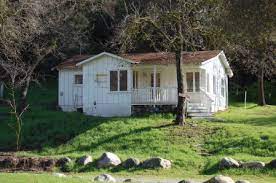
The Bequette House symbolizes a century and a half of hospitality and land stewardship. Even more so, it symbolizes community– a community that the house still helps sustain.
This article is a compilation of two articles written by John and Sarah Elliott for The Kaweah Commonwealth on July 14, 2014 and 3RNews on May 17, 2017, with historical background added by Laile Di Silvestro in April 2021.
 The Bequette House rests on a hillside next to the Three Rivers Historical Museum, overlooking the community gatherings and festivities that take place below, as well as the thousands of Sequoia National Park visitors that stop by each year to rest and seek the story of the locale.
The Bequette House rests on a hillside next to the Three Rivers Historical Museum, overlooking the community gatherings and festivities that take place below, as well as the thousands of Sequoia National Park visitors that stop by each year to rest and seek the story of the locale.
Built in 1926, the house sits on land occupied by the Wukchumni Yokuts for at least 3000 years. Euro-American settlers arrived in the mid 1800s, and by the mid 1870s the land now holding the Bequette House overlooked the Mineral King Road, which extended from Visalia to Mineral King during the mining rush of 1873-1883. At that time, an immigrant named Adam Bahwell and his wife Nancy acquired the land and constructed what is believed to have been the first public saloon in what was to become Three Rivers.
The land that holds the Bequette House also holds a story of tragedy and romance, and perhaps a share of uninhibited debauchery.
Part 1: The Bahwells
Adam Bahwell was a Hessian, born in 1830 in Napoleon Bonaparte’s empire. He left the Grand Duchy of Hesse in 1846, and was in California in 1847– preceding the earliest members of the California Gold Rush. Inevitably, he joined the rush and was living in the immigrant district of Calaveras in 1850 with two brothers from Mexico.
It is uncertain if he struck it rich; however, by 1859 he was in Tulare County. In 1860, he was penniless, living with a roommate in Visalia, and working as a wheelwright.
Two of his defining characteristics soon became clear, however. He was a shrewd businessman and women were not necessarily averse to his company. He married the 18-year-old Nancy Atlantic Stephenson in about 1861, and they commenced building a large family and business empire throughout Tulare County.
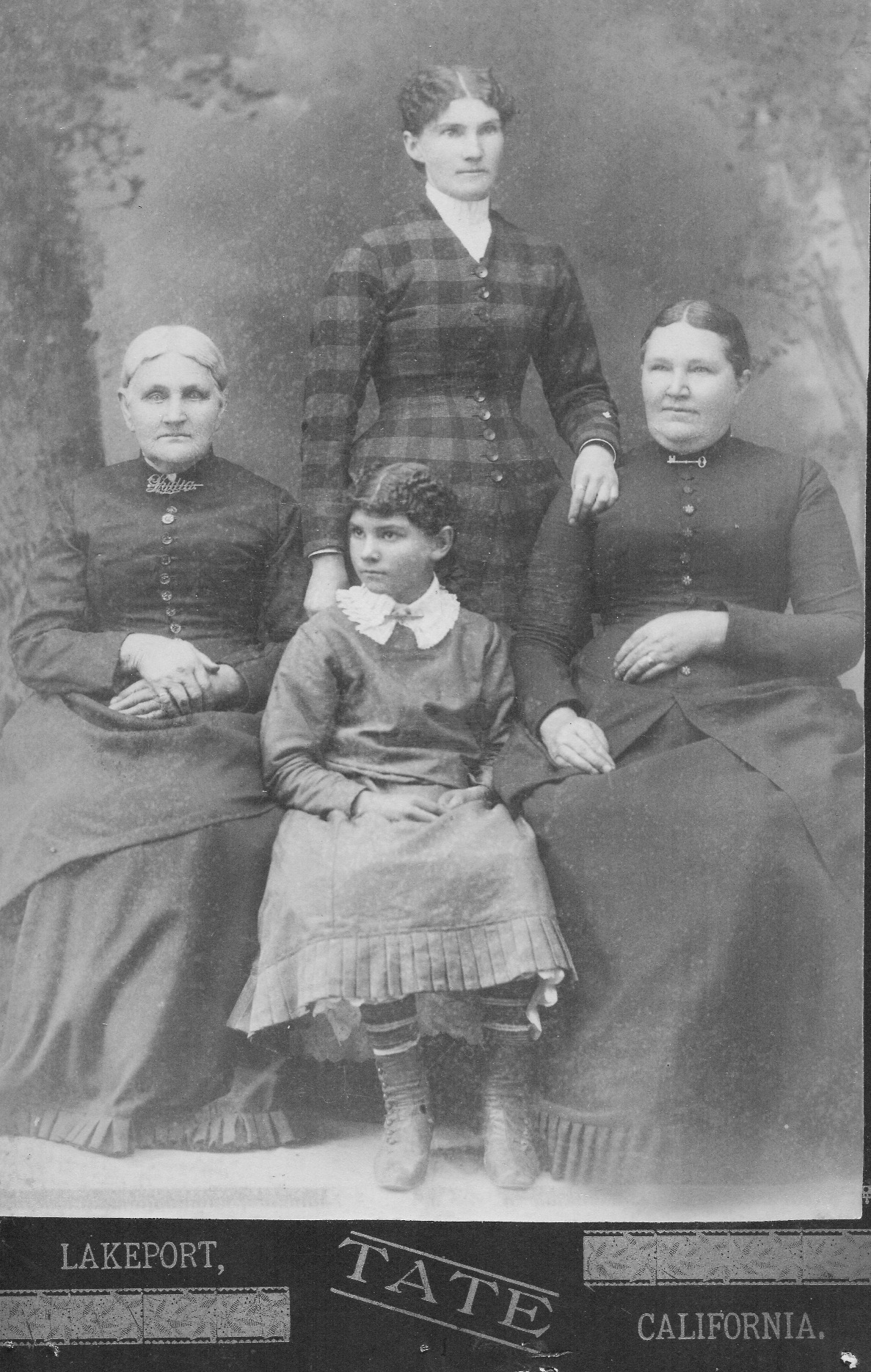
It is uncertain when the Bahwells acquired the land on which the Bequette House now stands. The official records indicate that the family lived in Visalia until 1880, when they moved to the property. We can assume that they had acquired the land at least a year or two earlier, and moved there only when there was a comfortable house for Adam, Nancy, and their six surviving children. Both the records and an obituary indicate that the family returned to their home in Visalia in 1881, however, and moved to Three Rivers permanently a few years later after they had added two more children their family.
The Bahwells established an orange grove and plant nursery on the property, and used it as a stopover when herding their sheep into the mountains for summer pasture.
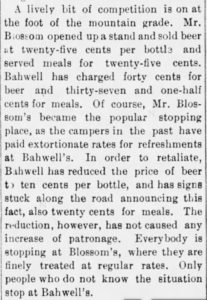
At some point, the Bahwells set up a hospitality business on the property. The earliest known references to it date from 1892 when the store was noted on a map. That same year, four soldiers from the 4th Cavalry assigned to protect the new Sequoia National Park partook in a drunken brawl at Bahwell’s, and one received serious cuts on his backside.
At the end of 1892 Nancy died, but Adam and the children kept the hospitality business alive.
By 1894, the Adam and his children were hosting boarders and feeding people on their way to Mineral King for a summer respite. That year they entered into a price war with the neighboring Blossom family, which had just set up a liquor and food stand on the side of the Mineral King road. The price of beer dropped from 40 cents to 10 cents a bottle!
By 1900, Adam considered his enterprise a veritable hotel, and his primary occupation that of hotel keeper. He died in 1901, and the land went to his son Charles Franklin before being acquired by John Allen MacKinnon and his wife Bessie in 1909. It appears to have been a “friends and family” transaction. Bessie was a Three Rivers resident and the daughter of Water Fry. Fry was a civilian ranger for Sequoia National Park and a close friend of the Bahwells. As testament to their friendship, when Charley Bahwell had a diabetic emergency in 1915, the Frys cared for him in their home until he died.
Part 2: The Bequettes
In the late 1840s and 1850s, an extended family of Bequettes migrated west from Missouri to join the gold rush in northern California. There the Bequette family settled and grew until several members migrated south to Tulare County in 1857. They put down roots in the Farmersville area where they amassed large quantities of land and eventually entered into the world of high finance as self-described capitalists.
When the Mineral King mining rush commenced in 1873, however, the Bequettes couldn’t resist.
Paschal Bequette Sr. (1806-1879), his son Paschal Jr. (1845-1925), and his nephews, the brothers Charles Clovis (1834-1916) and Cyprian Ladislas Bequette (1825-1875) made their way to Mineral King in June of 1874. Rather than prospect the slopes and canyons surrounding the Mineral King valley, however, they climbed over Farewell Gap. There they established Bullion City.
Although there is no record that the Bequette woman partook in the mining, women did live in Bullion City. One such woman was Harriett Hill (1834-1887), who became the first woman to sign her name on a mine claim in the Mineral King Mining District at a time when female ownership of mine claims was extremely rare. Perhaps as an indication of their progressive outlook, the Bequettes partnered with Harriet.
Although the Bequette family actively mined the area until the mid 1880s, the untimely death of Cyprian Ladislas in 1875 ended his branch’s involvement in mining. The family’s attachment to the area didn’t end, however. They established a ranch in the Lemon Cove area, and in 1924, Cyprian’s great grandson Bruce fell in love with a Three Rivers girl. She was Jessie Agatha MacKinnon, the granddaughter of Sequoia National Park superintendent Walter Fry, and the inheritor of the Bahwell land.
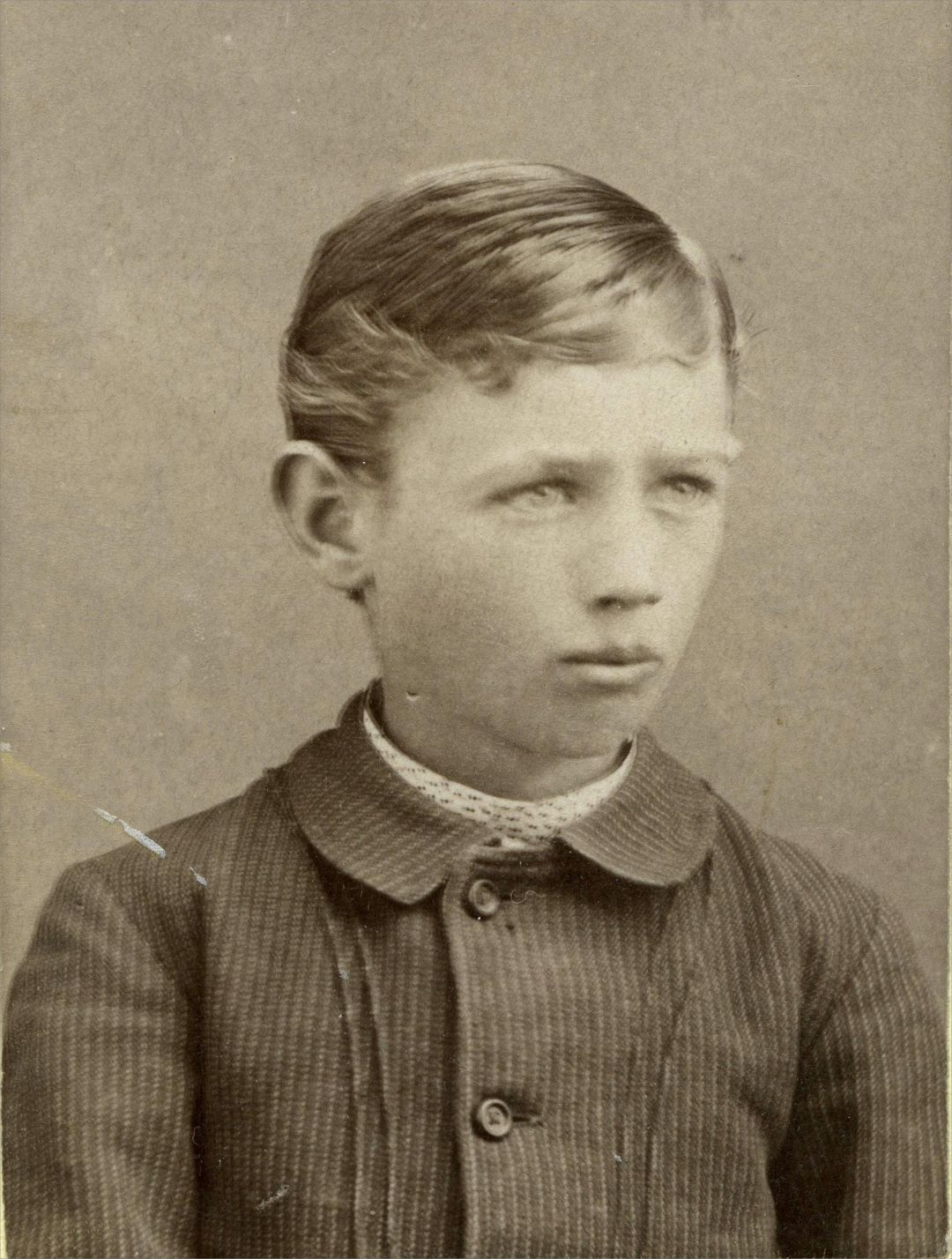
Part 3: Jessie’s Story
The following is excerpted from “A History of Woodlake Union High School – The Woodlake 11: Class of 1924,” by John Elliott (published in 1994, in cooperation with the Three Rivers Historical Society).
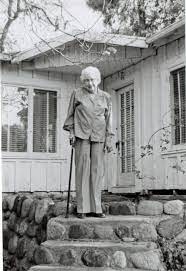 Jessie Agatha MacKinnon Bequette: I was born September 11, 1906, in the Pollasky Depot in Fresno. My parents, John and Bessie MacKinnon, lived in a small apartment upstairs. My father was employed by the San Joaquin Valley Railroad.
Jessie Agatha MacKinnon Bequette: I was born September 11, 1906, in the Pollasky Depot in Fresno. My parents, John and Bessie MacKinnon, lived in a small apartment upstairs. My father was employed by the San Joaquin Valley Railroad.
In 1907, we moved to Saskatchewan, Canada, where my father homesteaded a wheat farm. My mother later told me that the winters were so cold there that the milk would freeze when it was rushed from the barn to the house.
After two years of hard times, we moved home to Three Rivers [where her mother Bessie Fry MacKinnon was raised]. We lived for a time with my grandparents, Walter and Sarah Fry, while our house was being built a mile or so south of their place [on the old Bahwell property].
In 1910, we moved into our new house. It was the nicest home in Three Rivers and, I think, the only one with an inside bathroom. That was the same year my sister, Edith, was born in Fresno.
That wonderful home burned in a tragic fire in August 1914. My father died in that fire trying to save the family piano [a wedding gift from John to Bessie].
My [pregnant] mother, too depressed to stay in Three Rivers, moved with Edith to Tulare. That was the time, when I was seven years old, that my grandfather, Walter Fry, took charge of my upbringing. [She was living there when Charley Bahwell died in the house under Walter’s care.]
Some of my fondest memories are the Sequoia National Park inspection tours made on horseback as a youngster with Grandpa Fry. Each summer, we would start up the South Fork, crossing Hockett Meadow northward via the Tar Gap trail to the Montgomery cabin in Mineral King.
My first trip up the Colony Mill Road, the main route to Giant Forest before the completion of Highway 198 and Generals Highway in the 1920s, was in Grandpa’s Model T. Grandpa bought his first auto through the mail and learned to drive in his 40-acre pasture [near present-day Hawk Hollow Drive].
It was wonderful living at Grandpa’s house. It was the heartbeat of Three Rivers. There were lots of bedrooms; one on the first floor was his office while he was superintendent of Sequoia National Park [Walter Fry was the first non-Cavalry superintendent of Sequoia, 1912-1920].
The second story was a large, open room. It was great for parties and dancing.
I went to Sulphur Springs School from 1912 until 1920. The school was located north of the main river on what was then the Ogilvie ranch. We walked to school, crossing the river on a footbridge.
In all my high school memories, Senior Sneak Day [1924] had the biggest impact on my life. That was the day we put the big “W” on the hill above Woodlake, then went to Terminus Beach [present-day Terminus Dam at Lake Kaweah] for a picnic.
On that day, I noticed a handsome fellow named Bruce Bequette, who was playing golf nearby. Bruce had graduated from Woodlake High School in 1919, so he joined our class at the picnic.
Six months later, I married that man. We first lived at the Pogue Hotel in Lemon Cove [present-day Lemon Cove Women’s Clubhouse]. Bruce later got a job in Sequoia National Park. We had 43 wonderful years together.
* * *
In 1926, Bruce and Jessie built their Three Rivers home on the old Bahwell property where Jessie’s parents’ home had been.
Following, perhaps unknowingly, the course set by the Bahwells, they established hospitality services. They built an adjacent structure that became Bequette’s Gift Shop (1953-1967). There was also a gas station and a plant nursery where, during Bruce’s National Park Service career, he worked on a botanical project that shipped giant sequoia seedlings for experimental planting throughout the world.
In 1967, Bruce died suddenly from a heart attack. Jessie closed the gift shop and it remained vacant until 1975. That year it was purchased by Jeanette Barton, Jane Cheney, and Nancy Campe and became Mountain Arts, a gift shop and weaving store, for the next 20 years. In 1996, the business was sold and became Gallery 198 for one year. For the past 20 years, it has been, fittingly, the home of the Three Rivers Historical Museum.
Jessie resided in her little white house on the hill for 68 years, moving to Visalia in 1994 at the age of 87 to be near one of her nieces.
She and Bruce never had children.
Jessie died in Visalia on April 9, 2010.
Part 4: Preservation
The Three Rivers Historical Society purchased the 2.5-acre Bequette property in 2012. Since that time, the home has been under renovation.
Currently, it is in the process of being furnished with period pieces, including some of the Bequettes’ belongings, donated by nieces Joan Thomsen and Rachel Caggiano (Edith MacKinnon Perry’s daughters).
Three of Jessie’s dolls from childhood are in a glass case. A hutch in the dining area contains the couple’s Depression glass. A roll-top desk belonged to Jessie’s mother, Bessie; a barrister’s bookcase was Walter Fry’s. A treadle sewing machine belonged to Jessie’s sister, Edith Perry.
There is also a wood cookstove, a spinning wheel, and household furnishings. Still to come will be several themed gardens and a bathroom. The house will be available for group events and artist’s exhibits.
On the grounds, plans include the construction of a two-story barn, in addition to the new replica of the old Bahwell Saloon (the first public watering hole in Three Rivers) and a public-restroom facility.
This massive undertaking would not have been successful without the help of the community of Three Rivers. More than five dozen individuals donated time and/or money to the restoration, as well as public agencies and local businesses.
The house arose out of a community and sheltered people that helped hold that community together and keep it firmly attached to its roots. The Bequette house continues to bring community together, both to gather within its walls and to preserve it and its story.
